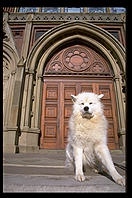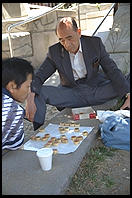
Canon EF 24-85/3.5-4.5 Lens
by Philip Greenspun; created 1996
Site Home : Photography : Canon EF 24-85/3.5-4.5 Lens

by Philip Greenspun; created 1996
Site Home : Photography : Canon EF 24-85/3.5-4.5 Lens
Though its image circle will cover a 35mm negative, this is the lens Canon introduced with its EOS IX APS SLR. When used with the smaller APS format, it yields angles of view equivalent to that of 30-106mm lens on a 35mm camera. Aperture ranges from a reasonable f/3.5 at 24mm to a still-reasonable f/4.5 at 85mm.
Admirably small and compact for a 35mm format zoom, the lens is huge and heavy compared to the (slower) 22-80 Minolta introduced with the Vectis S-1. Like the Minolta lens, the Canon zoom takes a bayonet plastic lens hood; unlike Minolta, Canon does not include the hood with the lens. That's a shame because a lot of amateurs won't know how to order the accessory part EW-73 and will never know how much contrast they are losing by not hooding this 12 group, 15 element lens.
On the plus side, the lens has a ring USM motor so you get full-time simultaneous AF/MF.
Oh yes, the image quality... I've only exposed a couple rolls film with it and they look reasonably good. The word from Canon is that it is performs about as well as the 28-105. It won't deliver the punch of the 28-70/2.8 or the prime lenses, but it won't leave a $1500 hole in your wallet or carve a notch in your shoulder either. I'd rather have the 24-85 than the 28-105 because I think the extra 4mm on the wide end are more useful than the extra 20mm on the long end.
Nit: The 24-85 uses a filter size of 67mm. All other Canon EOS lenses use 52, 58, 72, or 77mm filters. So this lens really doesn't fit that well in an existing EOS system.
Bottom Line: I've owned this lens for more than six months. It sits in my cabinet. For some reason, it simply isn't useful if you already have a full complement of higher-grade EOS lenses.
 I had to go to San Francisco to meet
with a publisher (see
the book behind the book
story) and the Environmental Defense Fund
(some planning for
www.scorecard.org). I
started packing at 6 am for an 8 am flight. I knew that I'd only have a few spare
hours in which to take pictures. I didn't want to take a P&S camera because
I'm growing less fond of them. The camera that I could easily grab was
the Rebel G plus the 24-85 lens. I walked around the city for an
afternoon and exposed 85 pictures on Kodak Royal Gold 400, with the intention of
adding them to
this California exhibit. I mostly used
aperture priority autoexposure and left the camera to autofocus (and pick its AF
sensor) all of the time.
I had to go to San Francisco to meet
with a publisher (see
the book behind the book
story) and the Environmental Defense Fund
(some planning for
www.scorecard.org). I
started packing at 6 am for an 8 am flight. I knew that I'd only have a few spare
hours in which to take pictures. I didn't want to take a P&S camera because
I'm growing less fond of them. The camera that I could easily grab was
the Rebel G plus the 24-85 lens. I walked around the city for an
afternoon and exposed 85 pictures on Kodak Royal Gold 400, with the intention of
adding them to
this California exhibit. I mostly used
aperture priority autoexposure and left the camera to autofocus (and pick its AF
sensor) all of the time.
I sent the undeveloped film directly to Advanced Digital Imaging where they were scanned to a single Kodak PhotoCD (check it out if you want to see my yield). I converted them using the software that I describe in my book. Here are the best (IMHO) of the 85 images:
Maybe it is the B+W UV filter that I keep on the lens, but I had a little flare problem taking pictures of the Transamerica Tower:
The bottom line? I found the combination practical for this photojournalism-type assignment.
Siemens is an ArsDigita client so I find myself in Bavaria from time to time. In order to save weight, I end up taking just the Rebel G and this lens. Here are some results:
The painted town of Oberammergau
Mad King Ludwig's castles
Munich
Text and pictures copyright 1996 Philip Greenspun